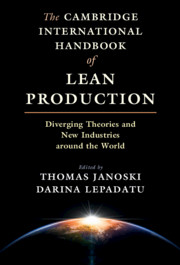 The Cambridge International Handbook of Lean Production
The Cambridge International Handbook of Lean Production Book contents
- The Cambridge International Handbook of Lean Production
- The Cambridge International Handbook of Lean Production
- Copyright page
- Dedication
- Contents
- Tables
- Figures and Sidebars
- Preface
- Acknowledgments
- Contributors
- Abbreviations
- 1 Lean Production as the Dominant Division of Labor
- Part I Theories of Lean Production
- Part II Lean Production across Industries
- 7 Challenges to Lean Implementation from a True Lean Toyota Production System Perspective
- 8 Lean Production in the Automotive Industry
- 9 Product and Process Innovation to Power the Lean Enterprise
- 10 Using a Lean Six Sigma Strategy to Be Resilient in the Telecommunications Sector
- 11 Lean Transformation in Healthcare
- 12 The Adoption of Lean Thinking by Legal Services Providers
- 13 Lean in Public Services
- 14 Mass Merchandizing and Lean Production at Walmart, Costco, and Amazon
- 15 Lean Management Systems and the Use of Financial Information
- 16 Lean Workflow and Quality Assurance when Creating Software-Intensive Products and Services
- Part III Lean Production Around the World
- Name Index
- Subject Index
- References
15 - Lean Management Systems and the Use of Financial Information
from Part II - Lean Production across Industries
Published online by Cambridge University Press: 11 March 2021
- The Cambridge International Handbook of Lean Production
- The Cambridge International Handbook of Lean Production
- Copyright page
- Dedication
- Contents
- Tables
- Figures and Sidebars
- Preface
- Acknowledgments
- Contributors
- Abbreviations
- 1 Lean Production as the Dominant Division of Labor
- Part I Theories of Lean Production
- Part II Lean Production across Industries
- 7 Challenges to Lean Implementation from a True Lean Toyota Production System Perspective
- 8 Lean Production in the Automotive Industry
- 9 Product and Process Innovation to Power the Lean Enterprise
- 10 Using a Lean Six Sigma Strategy to Be Resilient in the Telecommunications Sector
- 11 Lean Transformation in Healthcare
- 12 The Adoption of Lean Thinking by Legal Services Providers
- 13 Lean in Public Services
- 14 Mass Merchandizing and Lean Production at Walmart, Costco, and Amazon
- 15 Lean Management Systems and the Use of Financial Information
- 16 Lean Workflow and Quality Assurance when Creating Software-Intensive Products and Services
- Part III Lean Production Around the World
- Name Index
- Subject Index
- References
Summary
To paraphrase Brian Maskell, a prominent lean accounting pioneer, lean accounting is aligning financial management with the economics of lean. Traditional cost accounting or standard cost accounting has not changed its methodology in over 100 years, and often reports and other information generated are only superficially understood and hard to apply to real-world decision making even in non-lean companies. Then, as a company transitions to lean management and production, the accounting information becomes even less viable and much of it is useless. When accounting transitions to lean accounting, it partners with other functions including manufacturing. Through these partnerships, accounting gains a greater understanding of the company’s product and customer strategies. As a result, accounting informational output can be redesigned and enhanced to be more applicable, timelier, much easier to understand, and to better support the company’s lean transition needs. Decision makers at all levels will have more valuable information that can be utilized deeply in analysis and decision making. New output might include higher-value reports, box scores, visual displays in production, trend charts, key performance indicators, etc. In turn, accounting becomes a more collaborative and valuable partner and consultant in a company’s lean transition.
- Type
- Chapter
- Information
- The Cambridge International Handbook of Lean ProductionDiverging Theories and New Industries around the World, pp. 375 - 395Publisher: Cambridge University PressPrint publication year: 2021


